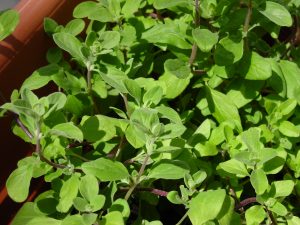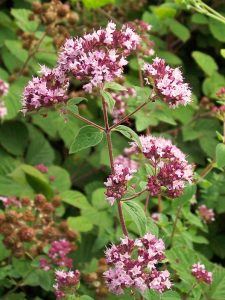Are you a fan of fresh aromatic herbs in your dishes? If so, growing marjoram right at home might just become your new favorite hobby. In this guide, we’ll explore how to grow marjoram at home. We’ll highlight growing conditions, pest and disease management strategies, and seasonal considerations specific to marjoram cultivation in Central Florida.

Commonly Grown Varieties
Marjoram is prized for its aromatic flavor and ease of cultivation, making it ideal for novice and seasoned gardeners.
- Sweet Marjoram (Origanum majorana):
- A popular variety known for its delicate leaves and sweet, slightly citrusy flavor.
- USDA Hardiness Zone: 9 to 11.
- Growing conditions: Full sun exposure and well-draining soil.
- Uses: Sweet marjoram adds flavor to a variety of dishes, including meats, vegetables, and soups.
- Greek Marjoram (Origanum heracleoticum):
- Offers a flavor with hints of pine and citrus.
- USDA Hardiness Zone: 3-11.
- Growing conditions: Full sun and well-draining soil.
- Uses: This variety is commonly used in Mediterranean cuisine, added to dishes like roasted lamb and tomato-based sauces.
- Variegated Marjoram (Origanum majorana ‘Variegata’):
- Stands out for its variegated leaves and subtle, sweet flavor.
- USDA Hardiness Zone: 9-11.
- Growing conditions: Partial shade and moist, well-draining soil.
- Uses: Its foliage makes it a beautiful addition to herb gardens, while its flavor complements salads, dressings, and marinades.
- Golden Marjoram (Origanum majorana ‘Aureum’):
- Features golden-yellow foliage and a mild, sweet flavor.
- USDA Hardiness Zone: 4-10.
- Growing conditions: Full sun exposure and well-draining soil.
- Uses: This variety adds a vibrant touch to dishes, including poultry dishes, potatoes, and herb-infused oils.
Growing Conditions
Soil Preparation
If you don’t already know your soil conditions, a great place to start is with a soil test. UF/IFAS Extension provides Soil Testing Services that are affordable and available to the public. The results will provide valuable information about your soil’s pH, fertility levels, nutrient content, and how to amend your soil to achieve an optimal pH range for your garden.
Marjoram thrives in moist, well-draining soil. In Florida, cultivating marjoram in raised beds can help regulate moisture retention and soil texture, particularly in sandy soils common to the region. Add organic matter (OM) to soils to ensure optimal growth. Marjoram prefers a soil pH range of 6.0 to 7.5.
Sunlight
Marjoram thrives in full sun but benefits from protection against Florida’s intense afternoon sun, especially during hot summers. This herb needs to receive at least 6-8 hours of sunlight daily. During winter, protect your plants from frost, as marjoram is sensitive to cold temperatures. Grow young marjoram on indoor sunny windowsills as an alternative until it is possible to transplant.
Fertilization
Marjoram prefers nutrient-rich, well-draining soil. The best place to start is with a soil test, so you can get the right kind of fertilizer for your plant, before planting or transplanting plants. Amend the soil with compost and fertilizer based on soil pH and nutrient content. Use any fertilizer according to label instructions for optimal growth and safety of use.
Read more about fertilizers in our Fertilizer Fundamentals series:
- Fertilizer Fundamentals: How to Choose the Right One – UF/IFAS Extension Pasco County (ufl.edu)
- Fertilizer Fundamentals: How to Apply Fertilizer – UF/IFAS Extension Pasco County (ufl.edu)
- Fertilizer Fundamentals: The Best Time to Fertilize – UF/IFAS Extension Pasco County (ufl.edu)
Pests and Diseases
Click here for more information on Integrated Pest Management (IPM).
Pests
While marjoram is relatively resistant to pests, it may encounter challenges from insects such as aphids, spider mites, and whiteflies. Monitor plants for signs of spider mite infestation, such as webbing and stippled leaves. Use insecticidal soap or neem oil to manage spider mites effectively.
-
- Treatment: Control aphids by spraying plants with a strong stream of water or applying insecticidal soap as needed. Always follow the label instructions on the product you use to prevent plant injury.
-
- Treatment: Monitor plants for signs of spider mite infestation, such as webbing and stippled leaves. Use insecticidal soap or neem oil to manage spider mites effectively. Always follow the label instructions on the product you use to prevent plant injury.
- Whiteflies: Whiteflies are small, winged insects that feed on the sap of plants, causing yellowing, wilting, and premature leaf drop.
- Treatment: Monitor plants for signs of infestation, such as webbing and yellowing leaves. Use insecticidal soap or neem oil to manage mites effectively. If necessary, consider introducing natural predators like ladybugs or lacewings to control infestations. In severe cases, remove and dispose of heavily infested plants to prevent the spread of whiteflies to neighboring vegetation.
Diseases
Marjoram is also susceptible to fungal diseases like powdery mildew, especially in humid conditions. Regularly inspect foliage for symptoms and practice good cultural habits to minimize disease incidence.
- Powdery Mildew: Powdery mildew appears as a white, powdery coating on leaves. It can cause leaf distortion and premature leaf drop. It is common in humid in humid conditions, so check your plant for these signs regularly.
- Treatment: To prevent the disease, space your plants out and grow them in a pot or raised bed with well-draining soil to improve air circulation. To treat diseased plants, apply fungicidal sprays containing sulfur or copper to control powdery mildew. Remember, always follow the label instructions on the product.
Seasonality
Marjoram thrives in Florida’s springtime temperatures. Plant marjoram outdoors after the frost threat has passed, typically in mid to late February. Or start seeds indoors 6-8 weeks before the anticipated last frost and transplant seedlings when they reach 5-6 inches in height. In fall gardens, continue harvesting marjoram until frost damages the plants.

Pruning Marjoram for Optimal Growth
Regular pruning promotes bushy growth, prevents premature flowering, and enhances leaf flavor. Follow these steps for marjoram pruning:
- Identify the Nodes: Prune marjoram at the points where leaves are attached to the stem, known as nodes. This encourages growth and maintains a compact shape.
- Prune Regularly: Trim marjoram plants as needed, particularly when they reach 6-8 inches in height. Avoid excessive pruning to prevent plant stress. Remove no more than one-third of the plant at a time.
- Remove Flower Buds: Pinch off flower buds as soon as they appear to redirect the plant’s energy towards leaf production. This prolongs the harvest period and keeps the flavor in the leaves.
How to Harvest and Store Marjoram
Harvest marjoram by clipping stems with sterile scissors. Store harvested stems in water for immediate use or cover the leaves with moist paper towels and refrigerate for extended freshness. Excess leaves can be frozen or dried for long term use.

Tips for the Floridian Gardener
Florida’s subtropical climate poses both challenges and opportunities for marjoram cultivation. Consider the following tips for successful marjoram gardening in Florida:
- Choose Heat-Tolerant Varieties: Opt for marjoram varieties suited to hot climates, such as Greek marjoram or golden marjoram. These varieties can withstand Florida’s high temperatures and humidity levels.
- Provide Afternoon Shade: Shield marjoram plants from intense afternoon sun by using shade cloth or selecting a partial shade location. This prevents the leaves from scorching from heat stress during summer months.
- Mulch and Water Wisely: Apply mulch around marjoram plants to conserve soil moisture and regulate temperature. Water marjoram to maintain even soil moisture levels, especially during dry spells. Make sure to check the water regulations in Pasco County when it comes to irrigation in your home garden.
- Monitor for Pests and Diseases: Regularly inspect marjoram plants for signs of pests and diseases Take proactive measures to mitigate issues before they become severe cases. Use pest control methods and choose disease-resistant marjoram varieties for optimal garden health.
Conclusion
By following these tailored tips for Florida’s climate, you can enjoy marjoram in your garden. Happy gardening!
Have a question?
If you have any questions about gardening in Central Florida, please contact UF/IFAS Extension Pasco County at 352-518-0156. For more information on UF/IFAS Extension Pasco County Community Gardens, and how you can join one, visit http://sfyl.ifas.ufl.edu/pasco/. Supervising agent: Dr. Whitney Elmore.
Follow us!
We have several ways to connect. Visit our Facebook, Instagram, Eventbrite, Blogs, Florida-Friendly Facebook, & Website.
More resources:
- UF/IFAS Extension Pasco County
- UF/IFAS Extension Pasco County Community Gardens
- Dr. Whitney Elmore’s Podcast: Rooted in Florida
 4
4
